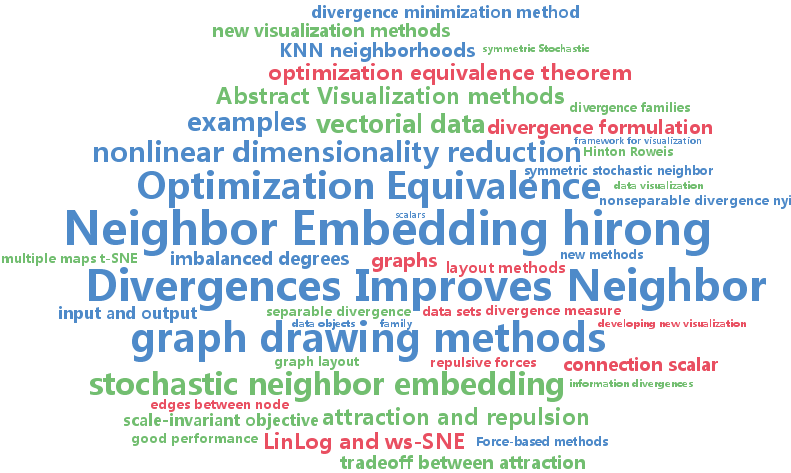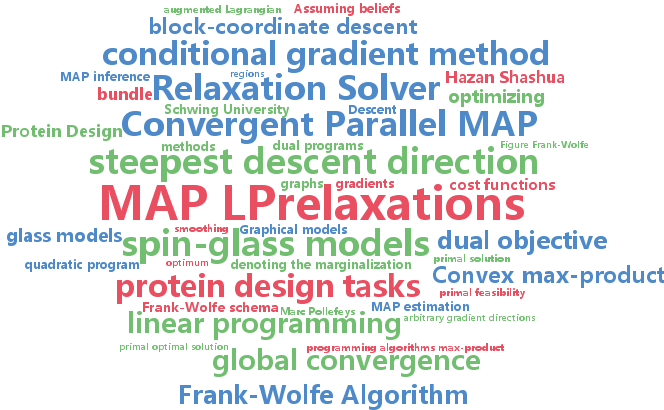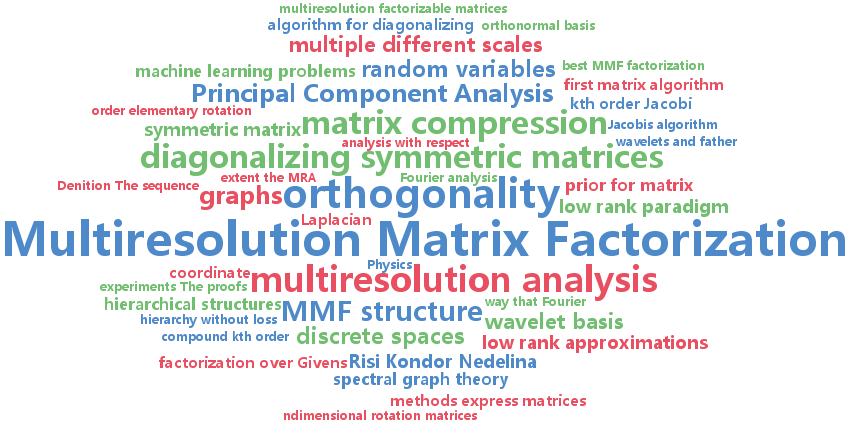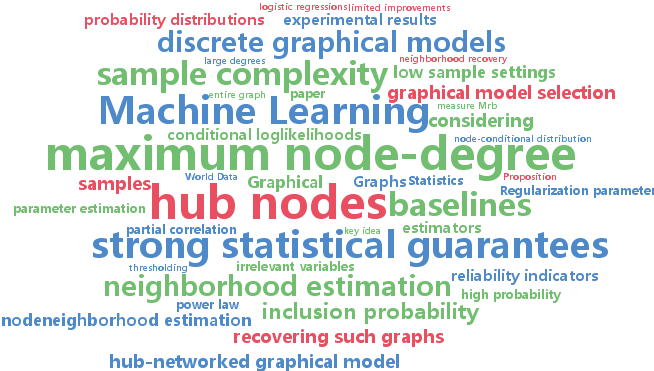graphs
-
Zhirong Yang and Jaakko Peltonen and Samuel Kaski
Optimization Equivalence of Divergences Improves Neighbor Embedding (pdf)
Visualization methods that arrange data objects in 2D or 3D layouts have followed two main schools, methods oriented for graph layout and methods oriented for vectorial embedding. We show the two previously separate approaches are tied by an optimization equivalence, making it possible to relate methods from the two approaches and to build new methods that take the best of both worlds. In detail, we prove a theorem of optimization equivalences between beta- and gamma-, as well as alpha- and Renyi-divergences through a connection scalar. Through the equivalences we represent several nonlinear dimensionality reduction and graph drawing methods in a generalized stochastic neighbor embedding setting, where information divergences are minimized between similarities in input and output spaces, and the optimal connection scalar provides a natural choice for the tradeoff between attractive and repulsive forces. We give two examples of developing new visualization methods through the equivalences: 1) We develop weighted symmetric stochastic neighbor embedding (ws-SNE) from Elastic Embedding and analyze its benefits, good performance for both vectorial and network data; in experiments ws-SNE has good performance across data sets of different types, whereas comparison methods fail for some of the data sets; 2) we develop a gamma-divergence version of a PolyLog layout method; the new method is scale invariant in the output space and makes it possible to efficiently use large-scale smoothed neighborhoods.
-
Alexander Schwing and Tamir Hazan and Marc Pollefeys and Raquel Urtasun
Globally Convergent Parallel MAP LP Relaxation Solver using the Frank-Wolfe Algorithm (pdf)
While MAP inference is typically intractable for many real-world applications, linear programming relaxations have been proven very effective. Dual block-coordinate descent methods are among the most efficient solvers, however, they are prone to get stuck in sub-optimal points. Although subgradient approaches achieve global convergence, they are typically slower in practice. To improve convergence speed, algorithms which compute the steepest $\epsilon$-descent direction by solving a quadratic program have been proposed. In this paper we suggest to decouple the quadratic program based on the Frank-Wolfe approach. This allows us to obtain an efficient and easy to parallelize algorithm while retaining the global convergence properties. Our method proves superior when compared to existing algorithms on a set of spin-glass models and protein design tasks.
-
Yuxin Chen and Leonidas Guibas and Qixing Huang
Near-Optimal Joint Object Matching via Convex Relaxation (pdf)
Joint object matching aims at aggregating information from a large collection of similar instances (e.g. images, graphs, shapes) to improve the correspondences computed between pairs of objects, typically by exploiting global map compatibility. Despite some practical advances on this problem, from the theoretical point of view, the error-correction ability of existing algorithms are limited by a constant barrier --- none of them can provably recover the correct solution when more than a constant fraction of input correspondences are corrupted. Moreover, prior approaches focus mostly on fully similar objects, while it is practically more demanding and realistic to match instances that are only partially similar to each other. In this paper, we propose an algorithm to jointly match multiple objects that exhibit only partial similarities, where the provided pairwise feature correspondences can be densely corrupted. By encoding a consistent partial map collection into a 0-1 semidefinite matrix, we attempt recovery via a two-step procedure, that is, a spectral technique followed by a parameter-free convex program called MatchLift. Under a natural randomized model, MatchLift exhibits near-optimal error-correction ability, i.e. it guarantees the recovery of the ground-truth maps even when a dominant fraction of the inputs are randomly corrupted. We evaluate the proposed algorithm on various benchmark data sets including synthetic examples and real-world examples, all of which confirm the practical applicability of the proposed algorithm.
-
Risi Kondor and Nedelina Teneva and Vikas Garg
Multiresolution Matrix Factorization (pdf)
The types of large matrices that appear in modern Machine Learning problems often have complex hierarchical structures that go beyond what can be found by traditional linear algebra tools, such as eigendecompositions. Inspired by ideas from multiresolution analysis, this paper introduces a new notion of matrix factorization that can capture structure in matrices at multiple different scales. The resulting Multiresolution Matrix Factorizations (MMFs) not only provide a wavelet basis for sparse approximation, but can also be used for matrix compression (similar to Nystrom approximations) and as a prior for matrix completion.
-
Rashish Tandon and Pradeep Ravikumar
Learning Graphs with a Few Hubs (pdf)
We consider the problem of recovering the graph structure of a ``hub-networked'' Ising model given iid samples, under high-dimensional settings, where number of nodes $p$ could be potentially larger than the number of samples $n$. By a ``hub-networked'' graph, we mean a graph with a few ``hub nodes'' with very large degrees. State of the art estimators for Ising models have a sample complexity that scales polynomially with the maximum node-degree, and are thus ill-suited to recovering such graphs with a few hub nodes. Some recent proposals for specifically recovering hub graphical models do not come with theoretical guarantees, and even empirically provide limited improvements over vanilla Ising model estimators. Here, we show that under such low sample settings, instead of estimating ``difficult'' components such as hub-neighborhoods, we can use quantitative indicators of our inability to do so, and thereby identify hub-nodes. This simple procedure allows us to recover hub-networked graphs with very strong statistical guarantees even under very low sample settings.
-
David Gleich and Michael Mahoney
Anti-differentiating approximation algorithms:A case study with min-cuts, spectral, and flow (pdf)
We formalize and illustrate the general concept of algorithmic anti-differentiation: given an algorithmic procedure, e.g., an approximation algorithm for which worst-case approximation guarantees are available or a heuristic that has been engineered to be practically-useful but for which a precise theoretical understanding is lacking, an algorithmic anti-derivative is a precise statement of an optimization problem that is exactly solved by that procedure. We explore this concept with a case study of approximation algorithms for finding locally-biased partitions in data graphs, demonstrating connections between min-cut objectives, a personalized version of the popular PageRank vector, and the highly effective "push" procedure for computing an approximation to personalized PageRank. We show, for example, that this latter algorithm solves (exactly, but implicitly) an l1-regularized l2-regression problem, a fact that helps to explain its excellent performance in practice. We expect that, when available, these implicit optimization problems will be critical for rationalizing and predicting the performance of many approximation algorithms on realistic data.





